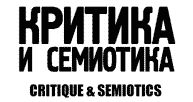VISUAL MARKERS OF THE URBAN IMAGINARY
DOI: 10.23951/2312-7899-2020-1-121-139
The article is devoted to the study of visual markers of urban imaginary, which provide the accumulation and representation of collective memories of the city, and structure the process of imagination of the city. The relevance of urban imaginary research is confirmed both by the increased scientific interest in the phenomena that symbolically and mentally determine urban reality, and by the episodic nature of urban imaginary research in Russia. Urban imaginary opens the possibility of an interdisciplinary view of the city as a global text, generated by the structuring of collective imagination and formed by the dynamics of urban meanings in time and space. The work focuses on the fact that people come into contact only with fragments of the city, and in the conditions of informatization, digitalization of reality, the city as a whole exists, first of all, in the imagination of people, which approximates and reduces the symbolic code of the city. The key thesis of the work is the statement that the most important symbolic representative, thanks to which urban imaginary is structured in a particular city, is visual markers of the urban imaginary, which have an exceptional imaginative and generating effect. The author addresses the process of urban imaginary construction, reveals the typology and specificity of Russian cities visual markers that act as symbolic mediators. The dominant markers considered in the article are natural, symbolic, architectural, personalized visual markers, which may have different configuration in each city and differently structure urban imaginary. The result of urban imaginary’s visualization process, which translates collective representations of the city, is an urban image. Based on the symbolic and partly virtual nature of urban imaginary, it is emphasized that the process of representation of the city and the constructed image today have more significance than the city really is. The results can be a starting point for the further urban imaginary research, including applied research. They are part of the intellectual capital that can be used by urban elites in the symbolic struggle of cities for space and mobile resources, as well as in solving the problems of increasing the competitiveness of Russian cities.
Keywords: city, urban studies, urban imaginary, visual markers.
References:
Abashev, V. V. (2014) Gorodskoye prostranstvo kak akkumulyator kollektivnoy pamyati. Vestnik Permskogo universiteta. Politologiya. 2. pp. 136–148. (In Russian).
Anderson, B. (2001) Voobrazhayemyye soobshchestva [Imagined Communities]. Moscow. (In Russian).
Augé, M. (1999) Ot goroda voobrazhayemogo k gorodu-fiktsii. Translated by B. Miziano. Khudozhestvennyy zhurnal ‑ Moscow Art Magazine. 24. [Online] Available from: http://www.guelman.ru/xz/362/xx24/x2402.htm (Accessed: 15.10.2018). (In Russian).
Avanesov, S. S. (2018) Gorodskoye prostranstvo kak antropologicheskiy fenomen [Urban space as anthropological phenomenon]. ΠΡΑΞΗMΑ. Journal of Visual Semiotics. 2 (16). С. 10–31. (In Russian).
Baudrillard, J. (2000) Simvolicheskiy obmen i smert' [L'échange symbolique et la mort]. Moscow. (In Russian).
Bloomfield, J. (2006) Researching the Urban Imaginary: Resisting the Erasure of Places. European Studies: A Journal of European Culture, History and Politics.. 23. pp. 45–61.
Castoriadis, C. (2003) Voobrazhayemoye ustanovleniye obshchestva [The Imaginary Institution of Society]. Moscow. (In Russian).
Chernyavskaya, O. S. (2013) Nizhniy Novgorod glazami nizhegorodtsev: vnutrenniy obraz goroda [Nizhny Novgorod as citizens see it: inside image of the city] // Vestnik Nizhegorodskogo universiteta im. N. I. Lobachevskogo. Seriya: Sotsial'nyye nauki. 1 (29). pp. 69–76. (In Russian).
Cinar, A., & Bender, T. (eds) (2007). Urban imaginaries: Locating the modern city. Minneapolis, London.
Fedotova N. G. (2017) Velikiy Novgorod glazami novgorodtsev: k voprosu o strukture territorial'noy identichnosti. Vestnik Novgorodskogo filiala RANKhiGS. 1 (7). pp. 259–265. (In Russian).
Fedotova N. G. (2018) Urban imaginary kak simvolicheskiy kapital goroda [Urban Imaginary as a Symbolic Capital of the City]. Yaroslavskiy pedagogicheskiy vestnik - Yaroslavl Pedagogical Bulletin. 2. pp. 228–233. (In Russian).
Fedotova, N. G. (2019) Visual carriers of city’s cultural memory (on the example of Veliky Novgorod) // ΠΡΑΞΗMΑ. Journal of Visual Semiotics. 2 (20). pp. 42–62. (In Russian).
Huyssen, A. (ed) (2008) Other cities, Other Worlds: Urban Imaginaries in a Globalizing Age. Durham (NC).
Lagodina, Ye. V. (2015) Voobrazhaya gorod. Izucheniye vospriyatiya gorodskogo prostranstva na primere Rostova-na-Donu [Imagining the city. the study of the perception of urban space on the example of Rostov-on-Don]. Severo-Kavkazskiy psikhologicheskiy vestnik. 13/1. pp. 23–27. (In Russian).
Le Goff, J. (2001) Srednevekovyy mir voobrazhayemogo [The Medieval Imagination]. Moscow. (In Russian).
Lefebvre, H. (2015) Proizvodstvo prostranstva [The Production of Space]. Moscow. (In Russian).
Lindner, R. (2017) Tekstura, voobrazhayemoye, gabitus: klyuchevyye ponyatiya kul'turnogo analiza v urbanistike. Sobstvennaya logika gorodov. Moscow. pp. 101–117. (In Russian).
Lynch, K. (1982) Obraz goroda [The Image of the City]. Moscow. (In Russian).
Musiyezdov, A. A. (2013) Gorod kak kul'turnaya forma [The city as a cultural form]. Sotsiologicheskoye obozreniye - Russian Sociological Review. 3. Т. 12. pp. 26–50. (In Russian).
Norberg-Schulz, Chr. (1980) Genius Loci, Towards a Phenomenology of Architecture. New York.
Riabova, L. K. & Valegina, K. O. Vospriyatiye goroda: Vyborg kak krosskul'turnoye prostranstvo [The perception of the city: Vyborg as a cross-cultural space]. Trudy istoricheskogo fakul'teta Sankt-Peterburgskogo gosudarstvennogo universiteta. 24. pp. 142–152. (In Russian).
Richardson, T. (2010) Replika. Antropologicheskiy forum. 13. pp. 173–182. (In Russian).
Soja, E. W. (2003) Postmetropolis. Kriticheskiye issledovaniya gorodov i regionov [Postmetropolis: Critical Studies of Cities and Regions]. The logos journal. 6 (40). pp. 133–150. (In Russian).
Zamyatin, D. N. (2010) Gumanitarnaya geografiya: prostranstvo, voobrazheniye i vzaimodeystviye sovremennykh gumanitarnykh nauk [Humanitarian geography: space, imagination, and interaction between contemporary human sciences]. Sotsiologicheskoye obozreniye - Russian Sociological Review. 3. Т. 9. pp. 26–50. (In Russian).
Zukin, S. (2001) Whose Culture? Whose City? The City Reader. Ed. by R. LeGates and F. Stout. Routledge. pp. 131–142.
Issue: 1, 2020
Series of issue: Issue 1
Rubric: ARTICLES
Pages: 121 — 139
Downloads: 803










